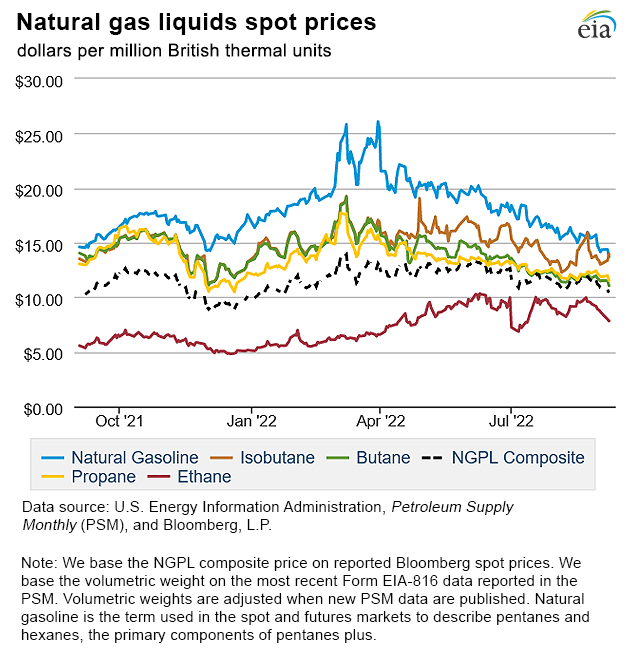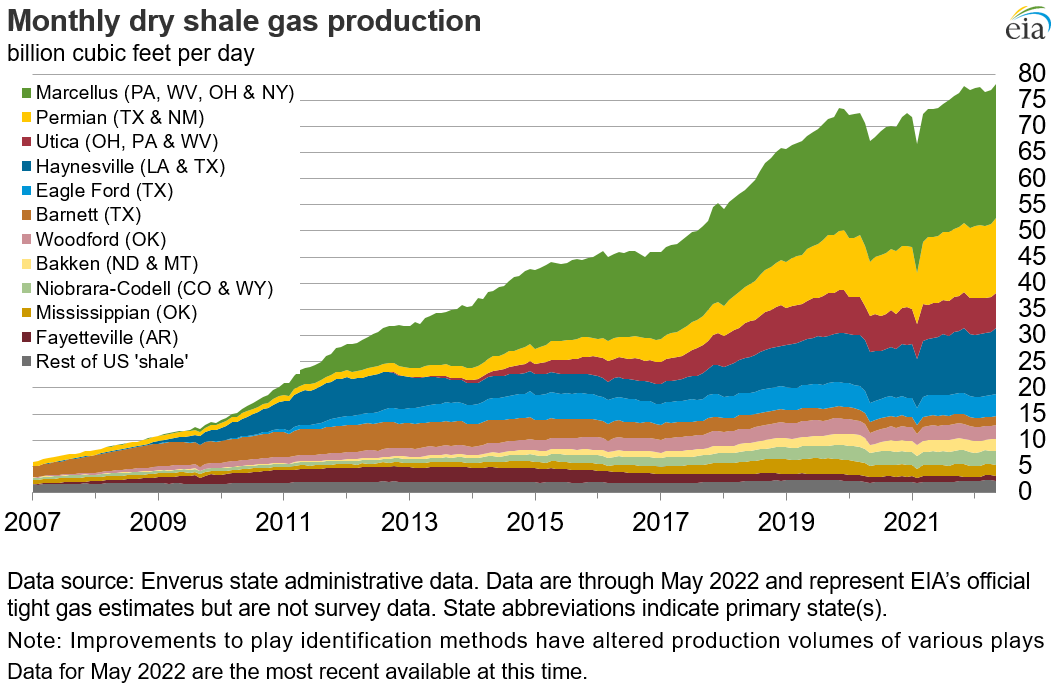In the News:
Waha Hub natural gas price differential to Henry Hub is widening in 2022
From late 2021 through August 2022, the natural gas price differential between the Waha Hub in West Texas and Henry Hub in Louisiana widened. The price of natural gas traded at the Waha Hub, which is near Permian Basin production activities, averaged $1.13 per million British thermal units (MMBtu) below the Henry Hub price in August, according to Natural Gas Intelligence. In comparison, in August 2021, natural gas at the Waha Hub traded at an average 26 cents/MMBtu below the Henry Hub price.
Regional natural gas prices can be influenced by in-region production rates and the availability of infrastructure to transport natural gas to high-demand regions. Maintenance on various pipelines transporting natural gas from the Permian region to consuming markets has contributed to a wider price differential at the Waha Hub. On May 2, natural gas flows on Kinder Morgan’s Permian Highway Pipeline out of the region decreased and the Waha Hub price fell to $1.82/MMBtu below Henry Hub. Last month, maintenance on the El Paso Natural Gas Pipeline, which reduced flows from West Texas into the Desert Southwest and California, contributed to the Waha Hub price discount to Henry Hub reaching $1.78/MMBtu on August 26.
Most natural gas production in the Permian region is associated gas, which is a by-product of (or associated with) crude oil production. Natural gas production in the Permian region more than doubled in the past five years, from an average of 7.8 billion cubic feet per day (Bcf/d) in 2017 to an annual high of 16.7 Bcf/d in 2021 as a result of increasing crude oil production in the region over the same time period.
From 2018 through early 2020, natural gas production in the Permian region grew faster than pipeline take-away capacity. To ensure their natural gas could be placed into the market given limited transportation capacity, producers sold their natural gas at discounted prices, resulting in a wider differential to the Henry Hub price. In 2019, the Waha Hub price differential to Henry Hub averaged $1.66/MMBtu.
In 2021, additional pipeline capacity to transport natural gas out of the Permian production region was put in service and the price differential between Waha Hub and Henry Hub narrowed. Increased pipeline capacity enabled producers to deliver natural gas from the producing area to demand centers in Mexico and along the Texas Gulf Coast, including liquefied natural gas (LNG) export facilities. Since April 2022, additional pipeline projects to deliver natural gas out of the Permian production region have been announced and, if completed as planned, would expand pipeline takeaway capacity by approximately 4.2 Bcf/d by the end of 2024.
Market Highlights:
(For the week ending Wednesday, September 7, 2022)Prices
- Henry Hub spot price: The Henry Hub spot price fell 82 cents from $8.95 per million British thermal units (MMBtu) last Wednesday to $8.13/MMBtu yesterday.
- Henry Hub futures prices: The price of the October 2022 NYMEX contract decreased $1.285, from $9.127/MMBtu last Wednesday to $7.842/MMBtu yesterday. The price of the 12-month strip averaging October 2022 through September 2023 futures contracts declined by 86.9 cents to $6.526/MMBtu.
- Select regional spot prices: Natural gas spot prices decreased in all regions this report week (Wednesday, August 31 to Wednesday, September 7), with prices at major pricing hubs declining between $2.88 at SoCal Citygate and $0.79 at Algonquin Citygate.
- Prices in California remain elevated this week, as demand in the electric power generation sector increased, driven by demand for air conditioning, as temperatures increased to well above normal. The price at SoCal Citygate in Southern California decreased $2.88 from $15.87/MMBtu last Wednesday to $12.99/MMBtu yesterday. The price at PG&E Citygate in Northern California declined $1.13, from $10.22/MMBtu last Wednesday to $9.09/MMBtu yesterday. The price at Malin, Oregon, the northern delivery point into the PG&E service territory, declined $1.50 from $9.25/MMBtu last Wednesday to $7.75/MMBtu yesterday. A heat wave enveloped much of the western United States this report week, with temperatures rising to well above normal, particularly in Southern California and the Desert Southwest. Yesterday, the California Independent System Operator (CAISO) issued an Energy Emergency Alert 2 to help the grid secure more supplies and urge market participants to lower demand on the system. Leading into this report week, temperatures in the Riverside Area, inland from Los Angeles, rose from 79°F on Monday, August 29 to 90°F last Wednesday, August 31. While the weekly average temperature was 13°F above normal this report week, daily average temperatures have begun to decline in recent days and temperatures are expected to continue to decline closer to normal through this weekend.
- At the Algonquin Citygate, which serves Boston-area consumers, the spot price declined by 79 cents from $8.43/MMBtu last Wednesday to $7.64/MMBtu yesterday. At the Transco Pipeline Zone 6 trading point for New York City, the price decreased 87 cents from $8.43/MMBtu last Wednesday to $7.56/MMBtu yesterday. In the Appalachia region, the Tennessee Zone 4 Marcellus spot price decreased 85 cents from $8.12/MMBtu last Wednesday to $7.27/MMBtu yesterday, and the price at Eastern Gas South in southwest Pennsylvania fell 81 cents from $8.10/MMBtu last Wednesday to $7.29/MMBtu yesterday. In the Boston Area, average temperatures declined from 77°F last report week to 67°F this report week, leading to 65 fewer cooling degree days (CDD) than last report week. In the New York-Central Park Area, average temperatures declined from 80°F last report week to 75°F this report week, leading to 36 fewer CDDs than last report week. Total consumption of natural gas in the Northeast region declined by 11%, or 1.8 billion cubic feet per day (Bcf/d) week over week, according to data from PointLogic. The decline was largely due to decreased consumption in the electric power generation sector, as lower temperatures led to lower demand for air conditioning.
- International futures prices: International natural gas futures prices declined this report week after reaching record highs the previous week. According to Bloomberg Finance, L.P., weekly average futures prices for liquefied natural gas (LNG) cargoes in East Asia decreased $7.95 to a weekly average of $56.07/MMBtu, and natural gas futures for delivery at the Title Transfer Facility (TTF) in the Netherlands, the most liquid natural gas market in Europe, decreased $17.13 to a weekly average of $66.49/MMBtu.
- Natural gas plant liquids prices: The natural gas plant liquids composite price at Mont Belvieu, Texas, fell by 66 cents/MMBtu, averaging $10.72/MMBtu for the week ending September 7. The price of ethane fell 10%, more than the natural gas price at the Houston Ship Channel, which fell 5%, leading to the ethane premium to natural gas falling by 77% week over week. The price of ethylene fell 4%, widening the ethylene to ethane premium by 17%. The natural gasoline price fell 7%, following the price of Brent crude oil, which fell 9%. The propane price fell 3%, resulting in the propane discount to crude oil decreasing by 22%. Normal butane and isobutane prices fell 3% and 2%, respectively.
Daily spot prices by region are available on the EIA website.
Supply and Demand
- Supply: According to data from PointLogic, the average total supply of natural gas rose by 1.1% (1.1 Bcf/d) compared with the previous report week. Dry natural gas production averaged 99.8 Bcf/d this report week, growing by 0.9% (0.9 Bcf/d) compared with the previous report week. Average net imports from Canada increased by 4.8% (0.3 Bcf/d) from last week.
- Demand: Total U.S. consumption of natural gas fell by 2.1% (1.5 Bcf/d) compared with the previous report week, according to data from PointLogic. Natural gas consumed for power generation declined by 3.2% (1.3 Bcf/d) week over week as cooler weather on the East Coast and Midcontinent balanced out the extreme heat affecting the West Coast. Industrial sector consumption increased by 1.2% (0.3 Bcf/d) week over week. In the residential and commercial sectors, consumption declined by 4.9% (0.4 Bcf/d). Natural gas exports to Mexico decreased 4.4% (0.3 Bcf/d). Natural gas deliveries to U.S. LNG export facilities (LNG pipeline receipts) averaged 11.2 Bcf/d, or 0.2 Bcf/d higher than last week.
Liquefied Natural Gas (LNG)
- Pipeline receipts: Natural gas deliveries to LNG export terminals in South Louisiana increased by 0.2 Bcf/d to an average of 7.9 Bcf/d, while deliveries to all other terminals were relatively flat week over week, according to data from PointLogic. Feedgas deliveries to Calcasieu Pass via the TransCameron pipeline were nearly 1.8 Bcf/d on Tuesday, a daily high, according to data from the pipeline operator. Overall natural gas deliveries to U.S. LNG export terminals increased by 0.2 Bcf/d to an average of 11.2 Bcf/d this report week.
- Vessels departing U.S. ports: Eighteen LNG vessels (seven from Sabine Pass, four each from Cameron and Corpus Christi, two from Calcasieu Pass, and one from Cove Point) with a combined LNG-carrying capacity of 67 Bcf departed the United States between September 1 and September 7, according to shipping data provided by Bloomberg Finance, L.P.
Rig Count
- According to Baker Hughes, for the week ending Tuesday, August 30, the natural gas rig count increased by 4 rigs from a week ago to 162 rigs. The Arkoma Woodford added two rigs, and the Haynesville and the Permian each added one rig. The number of oil-directed rigs decreased by 9 rigs from a week ago to 596 rigs. The Ardmore Woodford and the Eagle Ford each added one rig, and the Williston added two rigs. The Arkoma Woodford and the Cana Woodford each dropped one rig, the Permian dropped seven rigs, and four rigs were dropped in unspecified producing regions. The total rig count now stands at 760 rigs, which is 263 more than the same week last year.
Storage
- The net injections into storage totaled 54 Bcf for the week ending September 2, compared with the five-year (2017–2021) average net injections of 65 Bcf and last year's net injections of 48 Bcf during the same week. Working natural gas stocks totaled 2,694 Bcf, which is 349 Bcf (11%) lower than the five-year average and 222 Bcf (8%) lower than last year at this time.
- According to The Desk survey of natural gas analysts, estimates of the weekly net change to working natural gas stocks ranged from net injections of 47 Bcf to 66 Bcf, with a median estimate of 54 Bcf.
- The average rate of injections into storage is 5% lower than the five-year average so far in the refill season (April through October). If the rate of injections into storage matched the five-year average of 10.2 Bcf/d for the remainder of the refill season, the total inventory would be 3,296 Bcf on October 31, which is 349 Bcf lower than the five-year average of 3,645 Bcf for that time of year.
See also:
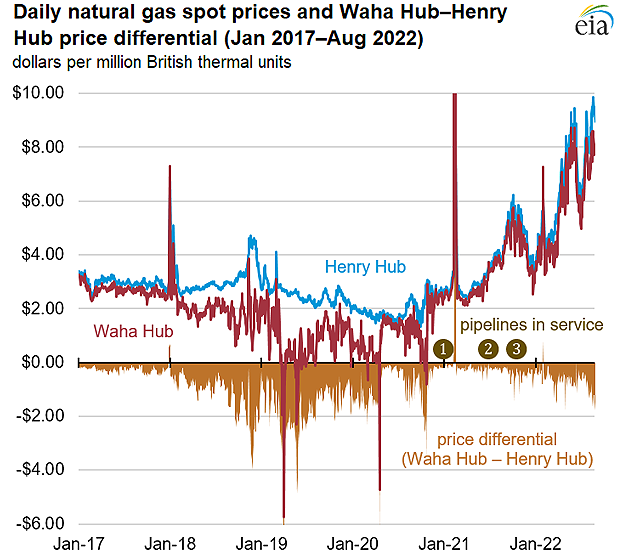
Data source: Natural Gas Intelligence
Note: Price differential is between the local market price (Waha Hub) and the national benchmark price (Henry Hub).
Pipelines in service: 1=Permian Highway (Jan), 2= Whistler (Jul), 3=Double E (Nov)
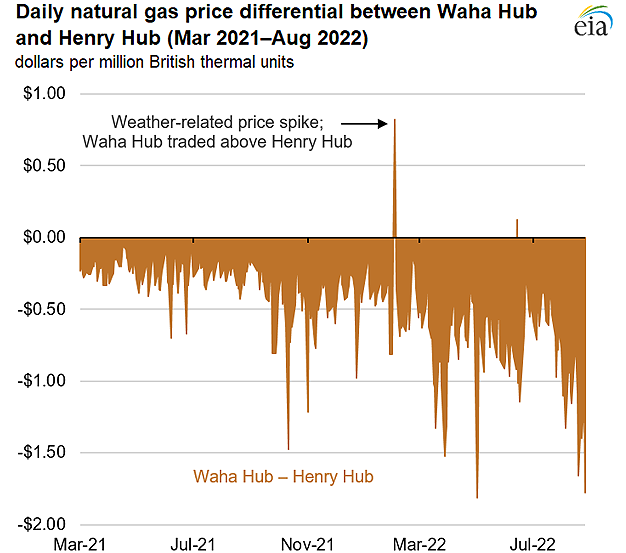
Data source: Natural Gas Intelligence
Note: Price differential is between the local market price (Waha Hub) and the national benchmark price (Henry Hub).
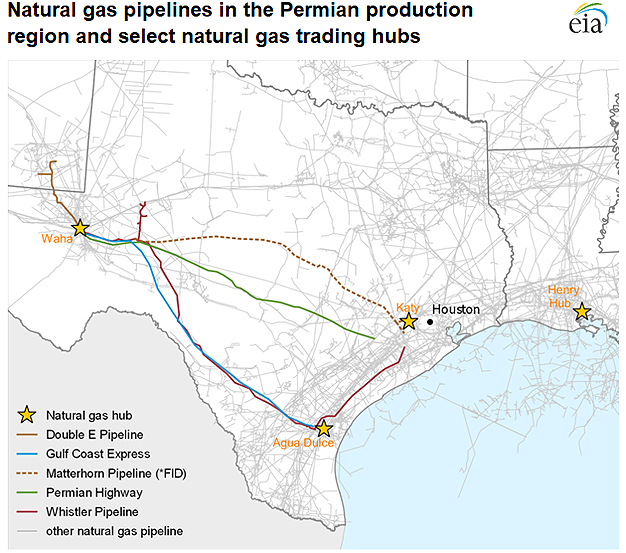 Data source: U.S. Energy Information Administration
Data source: U.S. Energy Information Administration *FID=final investment decision
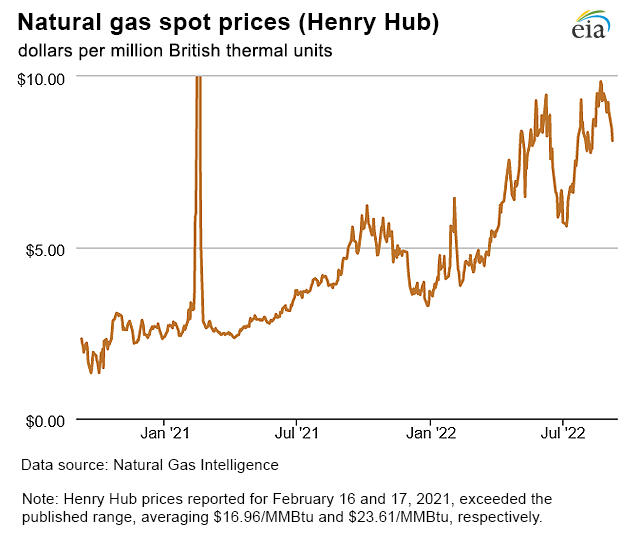
| Spot Prices ($/MMBtu) | Thu, 1-Sep |
Fri, 2-Sep |
Mon, 5-Sep |
Tue, 6-Sep |
Wed, 7-Sep |
|---|---|---|---|---|---|
| Henry Hub | 9.25 | 8.98 | Holiday | 8.47 | 8.13 |
| New York | 8.30 | 7.83 | Holiday | 7.88 | 7.56 |
| Chicago | 8.80 | 8.38 | Holiday | 7.93 | 7.60 |
| Cal. Comp. Avg.* | 11.33 | 10.39 | Holiday | 9.96 | 9.50 |
| Futures ($/MMBtu) | |||||
| October Contract | 9.262 | 8.786 | Holiday | 8.145 | 7.842 |
| November Contract | 9.330 | 8.850 | Holiday | 8.212 | 7.901 |
| Data source: Natural Gas Intelligence and CME Group as compiled by Bloomberg, L.P. *Avg. of NGI's reported prices for: Malin, PG&E Citygate, and Southern California Border Avg. |
|||||
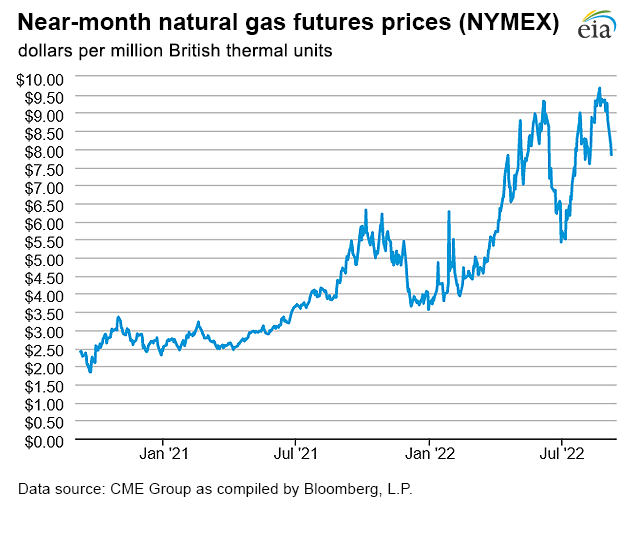
| U.S. natural gas supply - Gas Week: (9/1/22 - 9/7/22) | |||
|---|---|---|---|
Average daily values (billion cubic feet) |
|||
this week |
last week |
last year |
|
| Marketed production | 111.4 |
110.4 |
103.9 |
| Dry production | 99.8 |
98.9 |
91.8 |
| Net Canada imports | 5.8 |
5.6 |
4.4 |
| LNG pipeline deliveries | 0.1 |
0.1 |
0.1 |
| Total supply | 105.7 |
104.5 |
96.3 |
|
Data source: PointLogic | |||
| U.S. natural gas consumption - Gas Week: (9/1/22 - 9/7/22) | |||
|---|---|---|---|
Average daily values (billion cubic feet) |
|||
this week |
last week |
last year |
|
| U.S. consumption | 70.1 |
71.6 |
63.0 |
| Power | 40.0 |
41.3 |
34.4 |
| Industrial | 21.6 |
21.4 |
20.4 |
| Residential/commercial | 8.5 |
8.9 |
8.2 |
| Mexico exports | 5.5 |
5.7 |
6.2 |
| Pipeline fuel use/losses | 6.7 |
6.7 |
6.1 |
| LNG pipeline receipts | 11.2 |
11.0 |
10.6 |
| Total demand | 93.5 |
95.0 |
85.9 |
|
Data source: PointLogic | |||
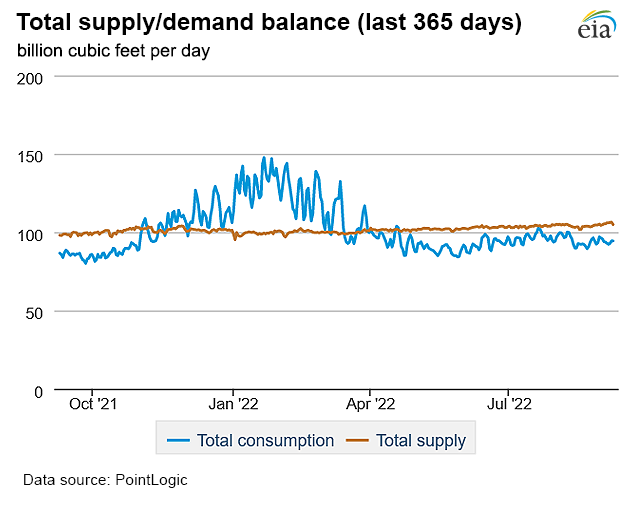
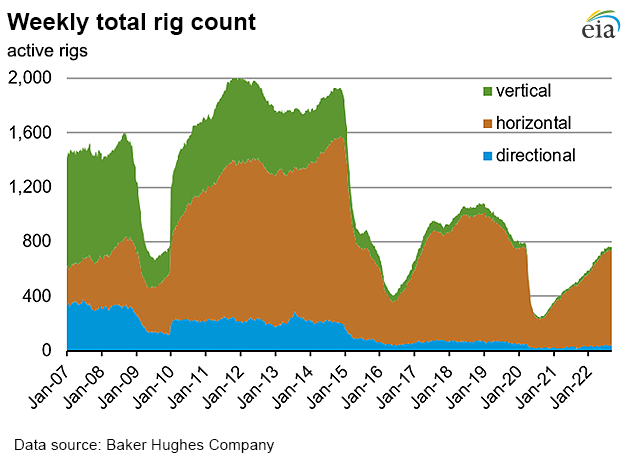
| Rigs | |||
|---|---|---|---|
Tue, August 30, 2022 |
Change from |
||
last week |
last year |
||
| Oil rigs | 596 |
-1.5% |
51.3% |
| Natural gas rigs | 162 |
2.5% |
58.8% |
| Note: Excludes any miscellaneous rigs | |||
| Rig numbers by type | |||
|---|---|---|---|
Tue, August 30, 2022 |
Change from |
||
last week |
last year |
||
| Vertical | 26 |
-16.1% |
13.0% |
| Horizontal | 695 |
0.1% |
50.1% |
| Directional | 39 |
-2.5% |
254.5% |
| Data source: Baker Hughes Company | |||
| Working gas in underground storage | ||||
|---|---|---|---|---|
Stocks billion cubic feet (Bcf) |
||||
| Region | 2022-09-02 |
2022-08-26 |
change |
|
| East | 635 |
614 |
21 |
|
| Midwest | 776 |
747 |
29 |
|
| Mountain | 159 |
157 |
2 |
|
| Pacific | 238 |
241 |
-3 |
|
| South Central | 887 |
881 |
6 |
|
| Total | 2,694 |
2,640 |
54 |
|
| Data source: U.S. Energy Information Administration Form EIA-912, Weekly Underground Natural Gas Storage Report | ||||
| Working gas in underground storage | |||||
|---|---|---|---|---|---|
Historical comparisons |
|||||
Year ago (9/2/21) |
5-year average (2017-2021) |
||||
| Region | Stocks (Bcf) |
% change |
Stocks (Bcf) |
% change |
|
| East | 699 |
-9.2 |
735 |
-13.6 |
|
| Midwest | 838 |
-7.4 |
843 |
-7.9 |
|
| Mountain | 191 |
-16.8 |
191 |
-16.8 |
|
| Pacific | 243 |
-2.1 |
274 |
-13.1 |
|
| South Central | 944 |
-6.0 |
1,001 |
-11.4 |
|
| Total | 2,916 |
-7.6 |
3,043 |
-11.5 |
|
| Data source: U.S. Energy Information Administration Form EIA-912, Weekly Underground Natural Gas Storage Report | |||||
| Temperature – heating & cooling degree days (week ending Sep 01) | ||||||||
|---|---|---|---|---|---|---|---|---|
HDDs |
CDDs |
|||||||
| Region | Current total |
Deviation from normal |
Deviation from last year |
Current total |
Deviation from normal |
Deviation from last year |
||
| New England | 1 |
-7 |
-1 |
53 |
33 |
3 |
||
| Middle Atlantic | 0 |
-5 |
0 |
67 |
35 |
-2 |
||
| E N Central | 1 |
-8 |
0 |
47 |
16 |
-29 |
||
| W N Central | 1 |
-12 |
-1 |
62 |
19 |
-9 |
||
| South Atlantic | 0 |
-1 |
0 |
97 |
17 |
-8 |
||
| E S Central | 0 |
-1 |
0 |
91 |
18 |
-5 |
||
| W S Central | 0 |
0 |
0 |
116 |
7 |
-9 |
||
| Mountain | 0 |
-16 |
-2 |
74 |
15 |
6 |
||
| Pacific | 1 |
-6 |
-3 |
65 |
25 |
9 |
||
| United States | 1 |
-6 |
-1 |
75 |
21 |
-6 |
||
|
Data source: National Oceanic and Atmospheric Administration Note: HDDs=heating degree days; CDDs=cooling degree days | ||||||||
Average temperature (°F)
7-day mean ending Sep 01, 2022
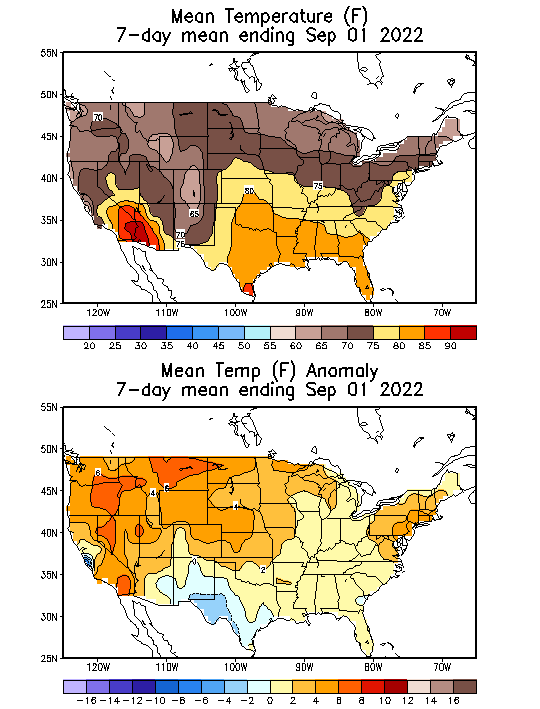
Data source: National Oceanic and Atmospheric Administration
Deviation between average and normal temperature (°F)
7-day mean ending Sep 01, 2022

Data source: National Oceanic and Atmospheric Administration

